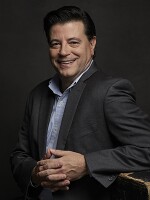The University of Hartford’s Silpe Gallery is part art exhibition, part giant quilting circle right now.
Art hangs on the wall, but for the next few weeks, Iranian artist Minoo Emami will be in the gallery preparing for a daring, almost unthinkable piece of performance art — she will destroy 22 of her paintings by fire, including early works dating from as early as 1998.
“I love my paintings, you know, don't take me wrong,” Emami said. “But compared to veterans, veteran’s families, and what they lose? It's nothing.”
With help of volunteers, mostly UHart students, the paintings are being sewn on a giant, black quilt that rests on the floor of the gallery. Many of the paintings depict artificial limbs in whimsical, sometimes surreal, settings.

Symbolically, the quilt will be destroyed on Veterans Day, Nov. 11.
The quilt is stitched together using surgical sutures, another important element of the work. Emami has been teaching project volunteers how to sew this way.
“I give them a demo of suturing, actually like the surgeon stitches,” Emami said. “So they suture the canvas to the quilt. And there's small cuts in the paintings and all of them have body parts, so they suture the canvases as well.”
“The sewing really felt like such an act of care, because of the intention behind it, how careful the process was,” said University of Hartford student Alison Bakke, who has been helping Emami stitch the quilt. “So, even though the paintings will be destroyed, it's almost like this ultimate act of grief in destroying them. It's an act of love, by letting them go and letting them transform into something else.”
For Emami, the art burning and the accompanying performance on Nov. 11 is a “ritual rooted in mourning.”
“Because deep in my heart, I am mourning,” Emami said. “I'm mourning for all the young Iranians who have been hurt during the past 45 years, and especially during the past year, and also for all families, everyone young and old who have been hurt with war and violence around the world in past years.”
The sacrificial burning is set for Nov. 11 at 2 p.m. in the Harry Jack Gray quad on the campus of the University of Hartford.
Not all of Emami’s work is being destroyed.
A retrospective of her other works is currently on exhibition at UHart’s Joseloff Gallery. “Minoo Emami: Under My Veil” runs through Dec. 16.






